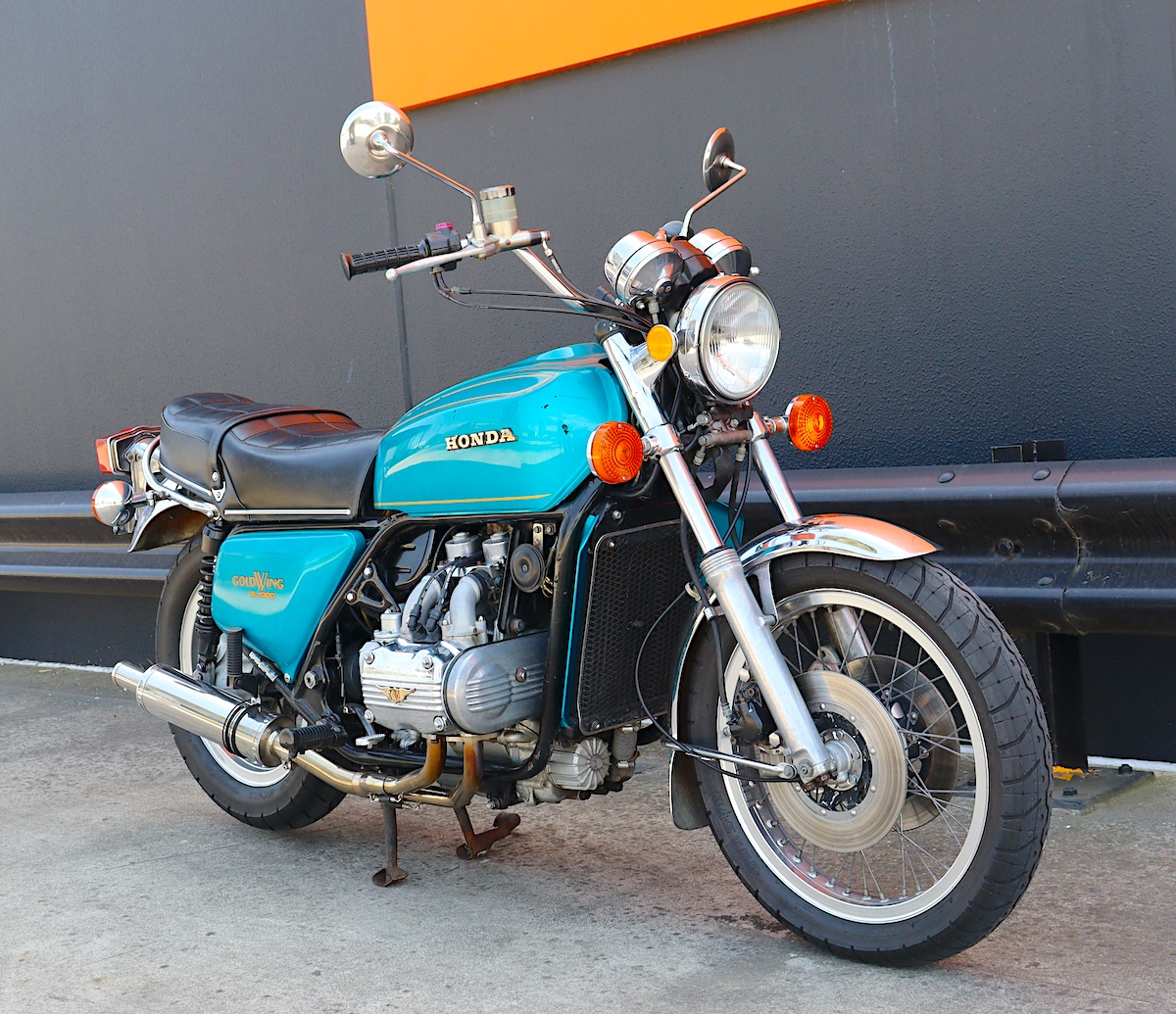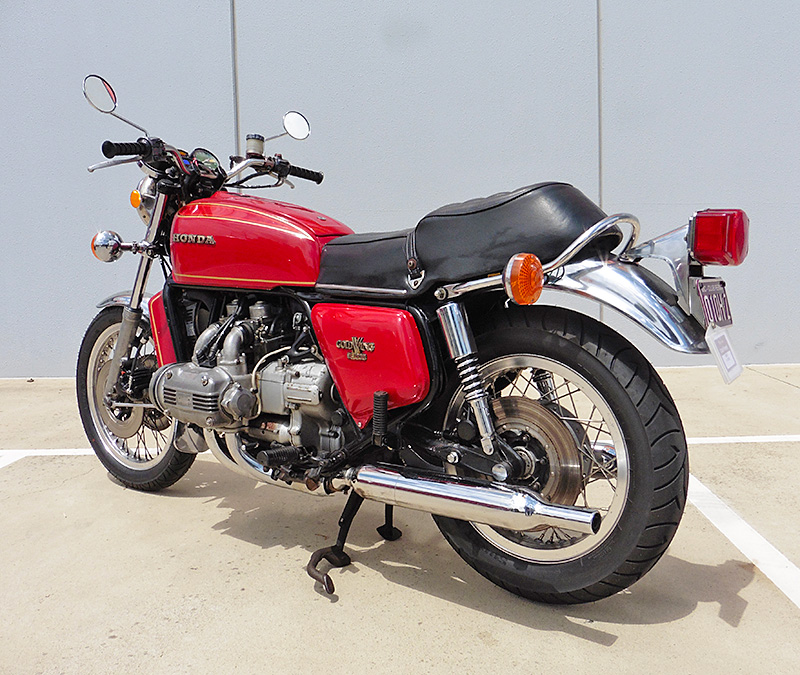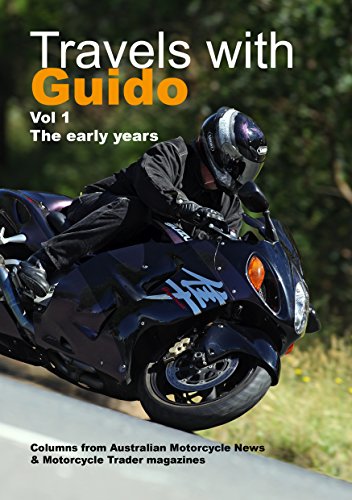Motorcycle Investor mag
Subscribe to our free email news

The Wing Nut files: American Idol take 2
Honda's 1975 launch of the flat-four GL1000 Gold Wing
was an incredibly bold move and for a while there it
looked like it might fail in the crucial American
market. A mere 49 years later, we've bought our second
example. It's a grey-import from, of course, America
(Feb 2024, Guy 'Guido' Allen)
Dammit! After all these years,
you'd think you'd know better. But, no, muggins buys and
sorts a first-model Honda Gold Wing then promptly sells
it. It was one of those dopey situations where the thrill
of the chase and the sorting was over, and I wrongly
assumed that was as good a time as any to offload the
thing.

It was a red version (above) and
immediately found a buyer at solid money.
Motorcyclists and car nuts are infamous
for buying back their youth in the form of something they
drooled over decades before, but this was taking it to a
new level: buying back last week – or so it seemed.
Anyway, young Brian Browne at TT Motorcycles in sunny
Mornington (Vic) had one for sale and I snapped it up. It
was a little rough around the edges, which was fine, and
included a promise of a service and fresh rubber. The
pipes that were on it were ropey, so I organised a set of
stainless steel Delkevic
replacements at a cost of Au$930. They make no
pretense of looking like the originals, but seem to be
decent quality and are road-legal on the noise front.
As much as I would have liked a set of
originals, or decent replicas, they're simply no longer
available.
Why go to all this trouble? Two reasons.
The first is I'm enjoying riding these old Gold Wings,
which make an interesting counterpoint to the Hayabusas
(and other indulgences) in the shed. They're quick for the
era and fun to throw around.
Secondly, I have this idea that I want a
big classic-era motorcycle that's reliable enough to
tackle a trip across the country. I'm thinking epic. It's
only a half-formed plot and the GL1000 so far meets the
job description.
With the bike purchased and the basics
sorted, we're right to go, yes? Well, not quite. This
machine was bought out of the USA and imported some time
in the last several years. However there are several steps
from there to getting it on the road.
Depending on which state you live in, and
the age of the bike, you will require:
a copy of the import approval, a VASS certificate to prove
it passes the Australian Design Rules (ADRs) of its build
era, plus a roadworthy certificate.
Now this varies from state to state. In
Queensland, I'm told a copy of the import approval and a
roadworthy would be sufficient to get it on the road. In
Victoria where I live, you need the full set, including
the VASS, if the bike was constructed after June 1975.
Mine was imported as a December 1975 build.
The VASS itself costs around $600, which
is the fee for an engineer to certify it meets
requirements. Add in a roadworthy check and you're up
around $900.
A bit of advice: if you are going through
a VASS process, have a chat with the engineer before the
inspection and get a clear idea of what's expected. In
this case there were a couple of potential wrinkles.
My Gold Wing had front running lights –
that is, the front indicators have two elements (like a
typical stop-lamp/tail-light globe), the 5W version of
which are on all the time. Rather than mess with the
wiring I simply blanked off the relevant globe contacts
with a bit of tape for the VASS test.
A bigger issue was that Australia had
switched to metric road measurements by 1975, so my GL was
supposed to have a km/h speedo to pass the period ADR,
which of course it didn't. The solution was to find an
aftermarket instrument that fitted and use it for the
test.
The VASS inspection plate was fitted to
the nearest piece of available frame, under the dummy fuel
tank.
That space was getting crowded, as I'd
already fitted a custom-engraved ID plate with maker,
model, date plus chassis and engine numbers – another VASS
requirement. It was sourced relatively cheaply through
Ebay and pop-riveted to a non-stressed frame member.
While this bike isn't exactly a concours
classic, I decided I wanted to keep it more or less in
American spec.
With all that done, we're fine, yes?
Almost. Here's a weird thing: both this machine and the
previous example at some point deteriorated and ran
poorly. In fact they were both bastards to start, were
difficult to get off the line and seemed to have lost much
of their famous bottom-end grunt. In both cases I
discovered the timing plate had slipped (presumably
through vibration), over-advancing the ignition. A quick
adjustment back (turn the plate anti-clockwise) did the
trick. They're not difficult to tune to a healthy state.
As a result I've paid particular
attention to fixing the timing plate in place. If you're
after a thorough tuning brief, get hold of the Clymer manual for
this model.
A GL1000 comes standard with points
ignition (two sets of breakers), which I have no problem
dealing with. However this bike has a Dyna solid state
replacement – I'm tempted to get another unit, since it
doesn't cost a fortune. Well, not compared to being stuck
in lower Yunta on a Sunday afternoon with no spares.
Back in 1975, the GL1000 qualified as
seriously weird cattle in the motorcycle world, with its
flat-four liquid-cooled powerplant, belt-driven cams and
sometimes odd architecture. Such as:
The camshaft-driven fuel pump hanging off the right-side cylinder bank;
The ignition timing set hanging off the
left-side bank;
The fuel gauge on the dummy fuel tank cover – the fuel tank is largely under the seat;
Much of the electrical system, including the regulator/rectifier set living behind the left-side of the dummy tank;
While the coolant reservoir and kickstart
lever live under the right. The latter is about as much
use as an ashtray, unless you're simply trying to turn
over the engine without actually getting it going.
So what's to like?
The engine is a winner. Notoriously
strong, it is largely owner-servicable. Honda's advice on
cambelts is to inspect every 100,000km (!), while the
valve clearances are screw and locknut. The plates for the
wet clutch can be replaced without removing the engine
from the frame.
It claimed 84hp (62kW), which doesn't
sound like much these days but was enough give bikes such
as a Kawasaki Z900 a hurry-up. It's at least as fast as,
and probably quicker than, my CB750-Four K1 and shows a
surprising willingness to rev into the redline if you
don't watch it.
The weak points were the clutch would not
take abuse such as dragstrip-style launches, closely
followed by a clunky transmission. A strength was the
relatively neutral shaft drive.
Braking was by single-piston discs all
round, which was okay for the era and requires a bit of
extra space in modern traffic.
As for handling, it's big, fairly heavy
and very 1970s. I've ridden much worse and you can sling
it at a corner with a reasonable degree of confidence.
It's not sharp, but it generally tries not to kill you.
One of the several things that intrigue
about the GL is how it has 'shrunk' over time. Not
literally, but in relation to what we have become
accustomed to. Back in 1975, this was a ridiculously big
motorcycle for many folk, famously derided as the Lead
Wing for its size and weight.
However these days it's nothing special –
a biggish motorcycle, for sure, but dwarfed by later
models. It looks petite when put beside my 2001 Valkyrie
Interstate.
I've recently taken the precaution of
doing an end-to-end fluid change, which should see it
settled for a while.
Was it a good decision to get it? Yep, so
far. I always look forward to throwing a leg over the
thing and come back with a grin.
Now, about that cross-country trip, it
needs to be big. Epic. Let's say 2025 to celebrate the
machine turning 50...
More on this bike: The Wing Nut files: the great owner manual hunt
See the Classic Two Wheels 1975 Gold Wing road test
See more of the bikes in our shed
-------------------------------------------------
Produced by AllMoto abn 61 400 694 722
Privacy: we do not collect cookies or any other data.

Archives
Contact




